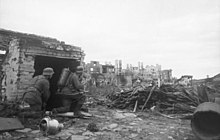Flamethrower 35

The Flamethrower 35 (or FmW 35) is a one-man flamethrower that was used in World War II .
history
German troops used flamethrowers for the first time as early as World War I. They achieved great success at the Battle of Verdun , which led to the fact that special flamethrower units were set up. Between the wars, serious work was done on the development of one-man flamethrowers and this resulted in the Flamethrower 35, which was produced until 1941 and then replaced by other models .
use
During the development of this flamethrower, main components from the First World War were adopted. Flamethrowers were used against bunkers , fortifications and armored vehicles during World War II and were relatively successful. But the risk of spontaneous combustion for the wearer was very high, because an enemy hit in one of the two tanks could lead to spontaneous combustion. The weight of 35.8 kg was another problem because the range of motion was limited by the heavy weight.
technology
The flame throwers were constructed according to the following principle: Each thrower had two tanks, one for flame oil, the other for a propellant, mostly nitrogen . As soon as the valve was opened, the propellant forced flame oil through the flame tube, where it was then ignited. The range of the flame jet was dependent on the oil throughput of the nozzle, the initial speed of the flame oil and the wind direction. The initial speed was determined by the pressure in the container and the length of the hose.
The flame beam was 25 to 30 m long and lasted around ten seconds, depending on the length of the individual volleys, which meant that up to 15 volleys could be delivered.
Technical specifications
| Parameter | Data |
|---|---|
| Amount of flame oil | 11.81 l |
| total weight | 35.8 kg |
| Pressurized gas | nitrogen |
| Number of possible bursts of fire | 2-15 |
| Range | 25-30 m |
literature
- Alexander Lüdeke: Weapons Technology in the Second World War. Infantry weapons, unarmored vehicles, armored vehicles, artillery, special weapons, aircraft, ships. Parragon Books, Bath 2007, ISBN 978-1-4054-8584-5 .